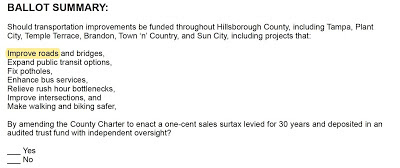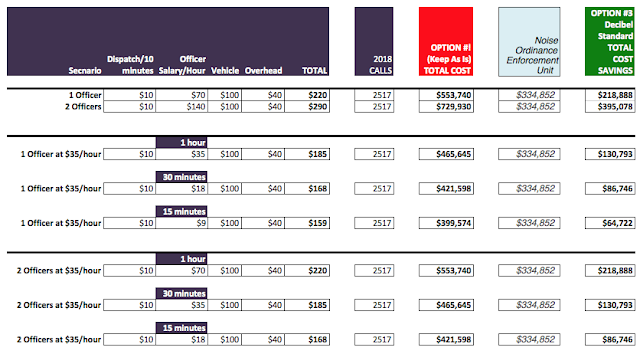
The All For Transportation (AFT) tax hike may turn
into one of the biggest scams ever perpetrated on Hillsborough County voters
and taxpayers.
We predicted the AFT would create a big mess and more evidence of that played
out at a Hillsborough County BOCC workshop held February 21, 2019.
The workshop to discuss how the county could spend $110 million of new AFT tax
proceeds quickly turned into a debacle. The commissioners darted in all
directions when confronted with the reality the $16 Billion AFT tax hike does
not fund new road capacity in Hillsborough County for 30 years.
These commissioners knew this issue before the election. Except for
Commissioner White, they all ignored the issue and did not properly inform the
voting public. That is incompetence.
Now some of these same commissioners want to raise the local gas tax.
The workshop began with the groundwork that all transportation projects must go
thru the "Independent Oversight Committee". What a misnomer! This
"Oversight" committee is unelected bureaucrats who are accountable to
no one yet have the authority to approve or disapprove all transportation
projects that can be funded by the $16 Billion AFT tax.
Note: Oversight committees are created to review, analyze, survey, monitor or
make recommendations but are not created to have approval/disapproval
authority. This committee was misnamed and should be called the Unelected
Bureaucrat's Approval Committee.
John Lyons, who oversees the county's Public Works department, began his
presentation and the workshop started going downhill. Lyons presents how 85% of
the $110 million the county would receive this year would fund maintenance,
safety and some intersection improvements for existing roads
and fund new bike paths and sidewalks.

|
|
|
How the County could spend
$110 million of AFT tax revenues
(Click to enlarge)
|
Lyons states Hillsborough County is 1231 square
miles of which 1000 of those miles are located in unincorporated Hillsborough
County. Lyons tried to make lemonade out of lemons but his wordy fluff could
not cover the reality of the bad policy the AFT tax hike is.
The video of this workshop can be found here and
the entire transcript can be found here.
It is worth watching the video or reading the entire transcript.
There are some nuggets from this workshop that are interesting.
Commissioner White immediately pointed out that AFT specifically restricts or
prohibits any funds in the top 4 categories (of the slide above) from being
used for new roads or adding new road capacity. White tells the commissioners
that only the last category "Remaining" funds "could" be
used to fund additional lane capacity or road widening.
White provides a public service by informing the public at this workshop that
the $16.5 million of the "Remaining" funds could only fund one-half
to three-quarters of a mile of added lane capacity a year. And that is IF the
county used every penny of their Remaining funds on new road capacity. AFT
intentionally allows these remaining funds to be used for any transportation
project including transit.
White tells his peer commissioners they must be transparent, especially to
their constituents in fast growing unincorporated Hillsborough, where 2/3 of
the population of the county reside. All the commissioners must be honest to
their constituents about how AFT, a political committee funded by downtown
special interests and accountable to no one, specifically restricts how they decided
to appropriate the tax hike proceeds.
SO
FOR EVERY COMMISSIONER AT THIS DAIS, THAT'S ACCOUNTABLE TO CITIZENS IN
EXPLODING SUBURBAN AREAS OF THIS COUNTY, I JUST WANT YOU TO BE AWARE OF WHAT
THIS MEANS, AS A MATTER OF POLICY, AND WHEN YOU'RE OUT SPEAKING TO RESIDENTS,
IN SUBURBAN, UNINCORPORATED HILLSBOROUGH COUNTY, YOU KNOW, MAKE SURE THAT
THERE'S COMPLETE TRANSPARENCY IN THE SENSE THAT, FOR THIS SALES TAX THAT COULD
RAISE AS MUCH AS $15 BILLION IN 30 YEARS.
300
MILLION IN A YEAR, AS I UNDERSTAND IT, $16.5 MILLION CAN GO TOWARDS ADDED LANE CAPACITY.
SO
I'M NOT GOING TO SUGAR COAT THIS, CITIZENS IN THE UNINCORPORATED AREAS OF THE
COUNTY WERE LED TO BELIEVE THAT THIS WOULD DELIVER ADDED ROAD CAPACITY. I
SAW THE CAMPAIGN FOR IT.
TWO‑THIRDS
OF THE PEOPLE OF THIS COUNTY THAT LIVE IN UNINCORPORATED HILLSBOROUGH COUNTY
WILL BE PAYING THIS $300 MILLION PER YEAR, $15 BILLION TAX AND IT'S RIGHT HERE,
RIGHT HERE ON THIS TABLE,
NO ROAD CAPACITY.
THAT
IS NOT WHAT THE RESIDENTS OF UNINCORPORATED HILLSBOROUGH COUNTY BOUGHT INTO.
AFT's $4 million marketing campaign claimed their
tax hike was "fixing" roads, reducing congestion and ensuring
everyone's commute time would be reduced so they would get home for dinner
quicker - for 30 years. AFT provided no evidence to back up their exaggerated false claims.
In reality, the AFT tax hike is a transit tax to force county taxpayers to
spend $7-8 Billion on costly transit in the city of Tampa and prohibit and
limit the funding of new road capacity - for 30 years. AFT's marketing
campaign, funded by special interests who will benefit from the transit tax,
was a deceptive and misleading facade.
All of these commissioners and county staff knew this. But all of them except
Commissioner White went along with AFT's charade.
No wonder the discussion at this workshop went downhill.
Commissioner Overman, who is not a traffic
engineer, said "it would be a wise idea for the individuals that need to
understand transportation planning what additional capacity means….you actually
can create the goal or achieve the goal of congestion reduction without adding
lanes to the process."
Did Overman tell voters that during the election?
Would she ever have told her constituents in New Tampa that congestion on Bruce
B Downs did not need to include road widening? Did Overman tell voters in South
County this tax hike does not fund new roads or additional road capacity?
Overman fails to acknowledge timing of lights and some intersection
improvements may increase some throughput on existing roads but they will never
relieve traffic congestion for a county that expects 700K or more residents over
the next 30 years - not including more tourists. Overman is not being truthful
but she is being condescending to her constituents, especially those in
unincorporated Hillsborough.
AFT's tax hike ballot summary language clearly states the tax hike will fund
projects to "improve roads" as if that is the tax hike's top
priority. Common sense and normal assumptions dictates that includes funding
new road capacity especially when "improve intersections" is also
included as a separate funding category.

|
|
|
All for Transportation Ballot Summary Language
(Click to enlarge)
|
All these commissioners and county staff knew the
fine print in AFT's 5
page charter amendment specifically prohibited funding new road
capacity and severely limited any of the $16 Billion being used for new roads
or road widening. They refused to inform the public.
Facing reality there is no new road capacity
funding for 30 years in the $16 Billion AFT tax hike, Commissioner Murman
brought up raising the local gas tax. Overman and Commissioner Smith, both
supporters of the AFT $16 Billion tax hike, agreed they want to raise the gas
tax.
Astounding! Taxpayers are handing over $16 Billion
of new AFT tax hike proceeds for transportation and some commissioners now want
to raise the gas tax because the AFT tax hike does not fund new road capacity.
Why didn't these commissioners tell their constituents this before the
election?
Commissioner Smith chimed in she thinks voters
voted to put massive amounts of new tax dollars (about $7-8 Billion) to pay for
costly transit and not to fund new roads. What evidence is there of that attitude?
AFT's $4 million marketing campaign focused on "fixing" roads. Did
Smith tell her voters that the vast majority of the transit funds that will be
spent in the city of Tampa will be paid for by taxpayers in unincorporated?
According to Smith, instead of road widening the
county needs to focus on getting some cars off the road. She prefers pursuing
another CSX/SunRail SunFail commuter rail. Smith fails to state what a
fiscal failure SunRail is with ridership so bad its fare box recovery only
covers 5% of its operating costs - meaning taxpayers are subsidizing the other
95%. SunRail's
farebox does not even cover the cost of its ticketing system. SunRail is one of the most
accident prone rail systems in the country and it has only been in service
since 2014.
Every commission district, except for the smallest
District 3 of Commissioner Miller, includes taxpayers of unincorporated
Hillsborough County. All of these commissioners better have an answer for why
their constituents, especially those in unincorporated Hillsborough, must pay
the vast majority of the billions for transit in the city of Tampa while not
getting new road capacity in unincorporated.
The most disturbing comment came from the BOCC
Chair Commissioner Miller:
THESE
WORKSHOPS I HOPE ARE NOT A PLATFORM TO DEBATE WHETHER THE PEOPLE KNEW WHAT THEY
WERE DOING OR NOT KNEW WHAT THEY WERE DOING.
THE FACT OF THE MATTER IS IT PASSED.
Miller, a former state legislator, apparently does
not care whether voters knew what they were voting for or whether what voters
were voting on was all legal. The only thing that matters to him is the $16
Billion tax hike passed.
When the end justifies whatever means, there will
be problems.
Commissioner Murman admitted it:
WE'RE JUST KIND OF BETWEEN A ROCK AND A HARD PLACE.
Why weren't voters and taxpayers told this before
the election?
This
post is contributed by EYE ON TAMPA BAY. The views expressed in this post are
the blog publisher's and do not necessarily reflect those of the publisher of
Bay Post Internet.





























